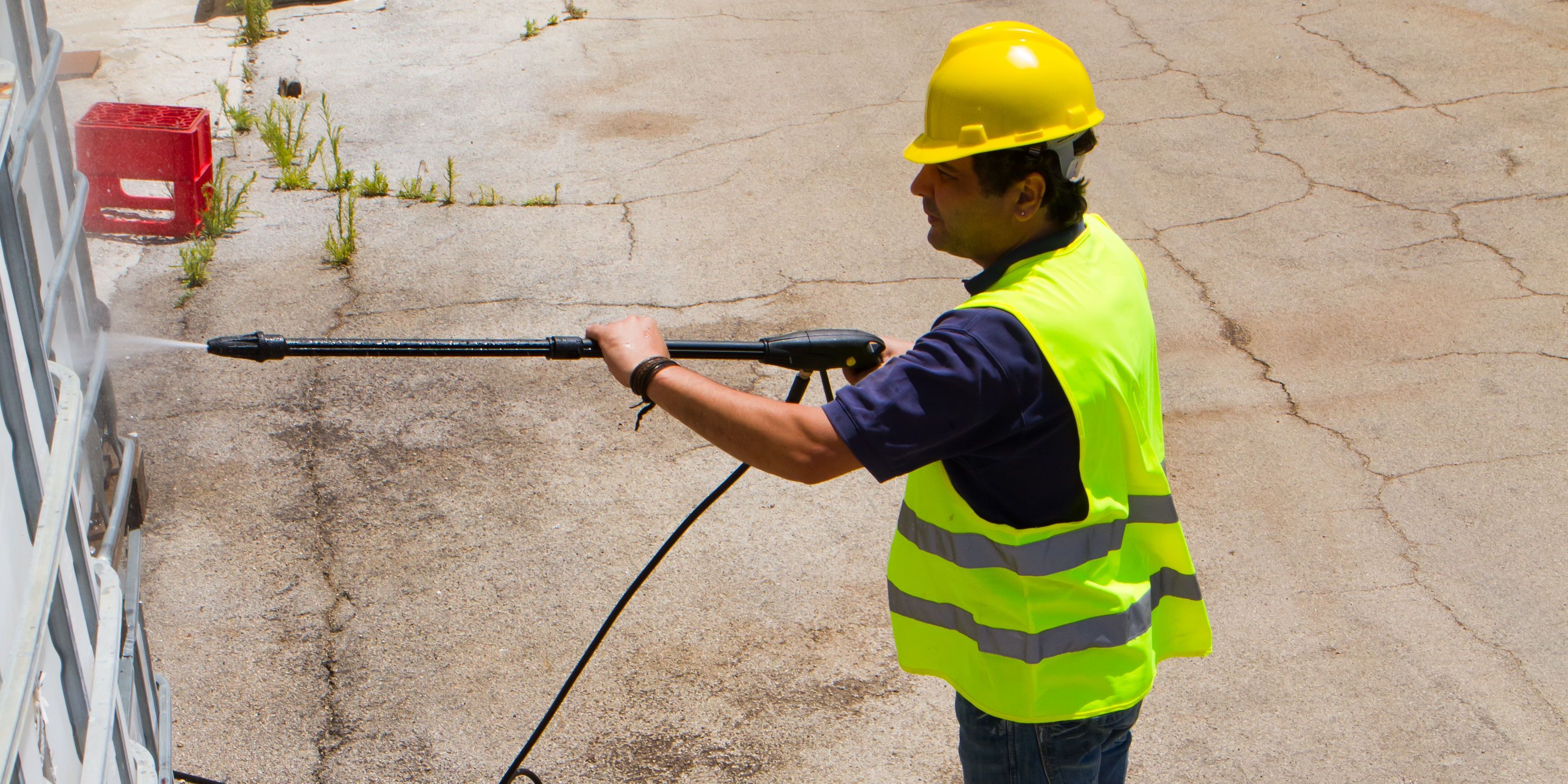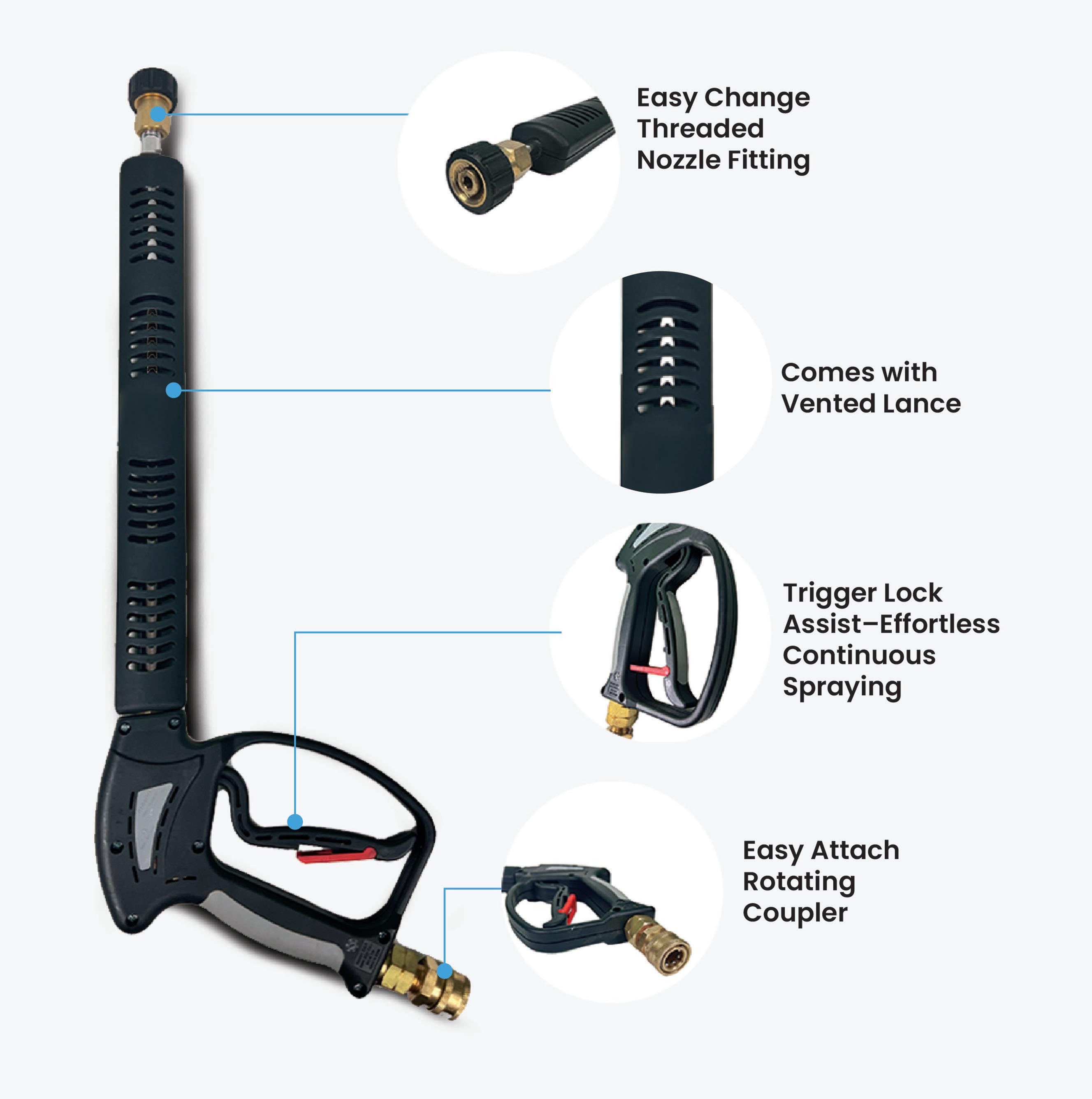
Pressure-Washing Spray Guns: A High-Powered Evolution
by Ken Hebert – BluBird Industries | Published April 2025

Ah, the pressure-washing spray gun—humanity’s answer to stubborn grime, questionable DIY projects, and the misguided belief that “more pressure is always better.” Over the years these mighty tools have evolved from crude, clunky contraptions to sleek, ergonomic cleaning machines that make filth tremble in fear.
Let’s dive into the gripping history, crucial selection criteria, and essential maintenance tips, so you can wield your spray gun like a seasoned pro (and avoid turning your deck into splinters in the process).
A Brief History of Pressure-Washing Spray Guns (Or, How We Learned to Harness Water Like a Superpower)
The origin story of pressure washing is almost as thrilling as a superhero movie. Back in 1926, Frank W. Ofeldt II accidentally discovered the first pressure washer while tinkering with a steam-powered whiskey still (because all great inventions start with whiskey). (See https://www.cleanertimes.com/magazine/cleaner-times-articles-2/the-history-of-pressure-washing-evolution-of-an-industry-part-one/.) Fast forward to the late 1970s and early ‘80s, when the introduction of ceramic plunger pumps transformed pressure washers from clunky water bazookas into efficient, safe, and (somewhat) user-friendly tools.
 Over the past three decades spray guns have shed excess weight and gained ergonomic designs, trigger safety latches, and quick-connect tips—because no one has time for complicated attachments when dealing with a driveway full of sludge. Hoses have also evolved, becoming more durable and resistant to wear, making them less likely to burst and create an accidental water park in your backyard.
Over the past three decades spray guns have shed excess weight and gained ergonomic designs, trigger safety latches, and quick-connect tips—because no one has time for complicated attachments when dealing with a driveway full of sludge. Hoses have also evolved, becoming more durable and resistant to wear, making them less likely to burst and create an accidental water park in your backyard.
Choosing the Right Spray Gun: A Survival Guide for Distributors and Contractors
Before you go blasting away at every surface in sight, let’s talk about how to pick the right pressure-washing gear. The job requirements should be your first consideration—different surfaces demand different nozzles and pressure levels. Pro tip: Just because it can strip paint doesn’t mean it should.
Environmental factors matter too. Temperature, weather conditions, and exposure to chemicals can turn your equipment into a ticking time bomb if you’re not careful. Safety is another major concern—pressure washers are surprisingly dangerous. Have you ever seen someone accidentally pressure wash their own foot? It’s not pretty.
Finally, weigh your budget against durability. Cheap equipment saves you money—until it breaks mid-job, and you’re left scrubbing your driveway with a sponge. A balance between cost and longevity ensures you won’t be replacing your gear every season.
Keeping Your Pressure Washing Equipment Alive
If you enjoy throwing money away on frequent replacements, feel free to ignore this section. But if you’d rather keep your spray gun and hose in top shape, here’s what you need to know.
Spray guns need regular checkups for leaks and cracks unless you like water spraying everywhere except where you need it. Clogged nozzles lead to weak, useless sprays that barely remove dust, let alone grime. Also, lubricate those O-rings—nothing says “failure” like a leaky, high-pressure disaster.
Hoses deserve just as much attention. Inspect them for cracks and bulges before each use, or learn the hard way what a surprise rupture feels like. Store them properly—kinks shorten their lifespan and not in a fun way. If a hose is damaged beyond repair, replace it. Duct tape won’t save you here.
Pressure Washing: Dos, Don’ts, and “What Were You Thinking?”
Proper Uses (a.k.a. How to Clean Like a Pro)
Using the right nozzle and pressure setting is key to getting results without causing damage. Concrete or brick surfaces require a wide fan tip (25°–40°) with high pressure. Wood decks need a narrower tip (15°) with lower pressure to avoid looking like they were attacked by a beaver. Delicate surfaces, such as siding or windows, demand a very wide fan tip (60°+) and low pressure unless you enjoy buying new windows.
Engaging safety features like trigger latches is also a must. Always lock the trigger when not in use to prevent accidental sprays. Test all safety mechanisms before starting because discovering they don’t work after pressing the trigger is never a good surprise.
Improper Uses (a.k.a. What Not to Do Unless You Like Regret)
Blasting fragile surfaces with high pressure is a surefire way to destroy them. Windows? Expect shattered glass. Vinyl siding? Say goodbye to your paint job. Wood? Enjoy a deck that looks like it lost a fight with a chainsaw.
Ignoring safety gear is another classic mistake. No safety glasses? Say hello to water-powered shrapnel. No gloves? Enjoy the sensation of high-pressure water peeling your skin. No protective clothing? You might as well tattoo “I like pain” on your arm.
Troubleshooting: Because Things Will Go Wrong
Spray guns can be tricky. If you notice leaks at the connections or O-rings, prepare for an unexpected shower. If the trigger mechanism isn’t working, your spray gun is now just a fancy-looking stick. And if the body is leaking, just replace it—unless wasting water and money is your hobby.
Hoses require equal attention. Identifying leaks early can save you from a full-blown geyser situation. Never, and I mean NEVER, attempt to repair a high-pressure hose. That’s a disaster waiting to happen. Also, check fittings and connections—loose parts and high pressure do not mix well.
Final Thoughts: Clean Smarter, Not Harder
Pressure-washing spray guns have come a long way, from whiskey-still accidents to high-powered grime-fighting machines. Whether you’re a distributor, a contractor, or an overenthusiastic homeowner, using the right equipment, treating it well, and not using it to strip the paint off your car (yes, it happens) will keep you cleaning like a pro.
Now, go forth and blast away that dirt—responsibly.
For more information about BluBird Industries, call 844-769-4673, email sales@blubirdindsustries.com, or visit www.blubirdindustries.com.

